12 Tall Perennials With The Best Pink Flowers in Bloom

This post follows our research editorial guidelines.

Are you on the hunt for some tall perennials with stunning pink flowers? Look no further! As a fellow garden enthusiast, I’ve done some digging to bring you 12 of the best options out there.

These plants add some much-needed height to your garden and provide a pop of vibrant pink color that are sure to impress. I love combining cool and warm colors like this in my garden, try planting next to shrubs with red leaves for a fiery garden landscape. From old favorites like the peony to lesser-known gems like the blazing star, there’s a perennial to suit every taste and growing condition.
So, let’s dive in and explore these beautiful pink perennials together!
Quickly Find Tall Pink Perennials:
1. Mountain Cornflower (Centaurea montana)

As a gardening lover, mountain cornflower is one of my favorites! This striking perennial is known for its beautiful blue-violet flowers that add color to any garden. The blooms are so eye-catching that they’re sure to draw in plenty of attention from butterflies and bees, making them an excellent choice for pollinator gardens.
Another great thing about the mountain cornflower is that it’s a long-blooming plant, with flowers appearing for several weeks in the summer. Deadheading spent blooms can encourage the plant to produce even more flowers, extending the blooming season even further.
One thing to remember when growing mountain cornflower is that it can self-seed quickly, spreading beyond its intended planting area. However, this can also be positive if you want to create a naturalized look in your garden. Just monitor the plant’s spread and remove any unwanted seedlings as needed.
| Botanical Name: | Centaurea montana |
| Growth Rate: | Moderate |
| Blooming period | Long |
| Hardiness Zones: | 3-7 |
| Light: | Full sun to partial shade |
| Soil Needs: | Well-draining |
2. Monarda Balmy Pink (Monarda didyma)
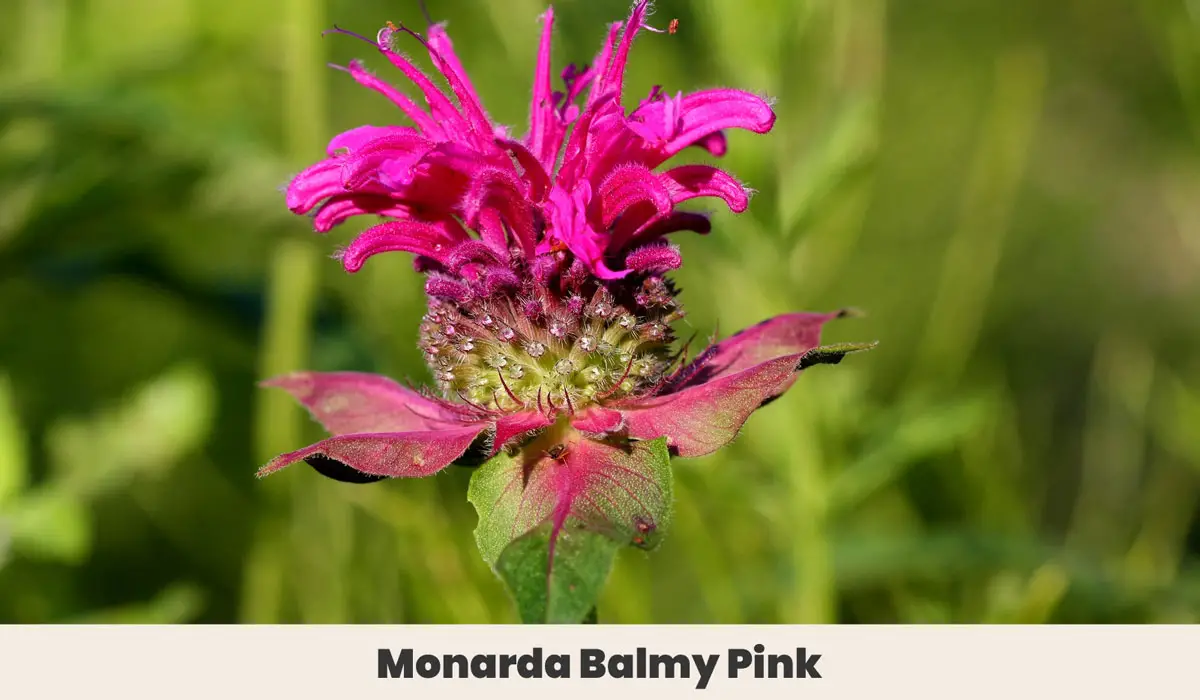
I’m always looking for unique and beautiful plants to add to my garden, and Monarda Balmy Pink (Monarda didyma) fit the bill! This stunning perennial is a member of the mint family known for its fragrant foliage and eye-catching pink blooms.
One of the things I love about Monarda Balmy Pink is its compact size. At only 18 to 24 inches tall, it’s perfect for smaller gardens or for adding pops of color to mixed borders. And speaking of color, the pink flowers of this plant are gorgeous! They appear in mid to late summer and are loved by hummingbirds and butterflies, making them an excellent choice for pollinator gardens.
But Monarda Balmy Pink isn’t just pretty to look at – it’s also a valuable plant for natural pest control. The fragrant foliage of this plant is known to repel pests, which can help keep your garden healthy and thriving.
With some care, this plant will reward you with months of beautiful blooms and fragrant foliage.
| Botanical Name: | Monarda didyma |
| Growth Rate: | Fast |
| Blooming period: | Long |
| Hardiness Zones: | 4-9 |
| Light: | Full sun to partial shade |
| Soil Needs: | Well-drained soil |
3. Skyward Pink (Veronica longifolia)

I love having plants in my garden that are easy to grow, and Skyward Pink is one of those. This stunning perennial is a member of the Speedwell family known for its tall spikes of vibrant pink flowers.
Skyward Pink blooms from mid-summer to early fall, making it an excellent choice for extending the flowering season in your garden. The flowers are a bright pink shade and attract various pollinators, including bees and butterflies.
One of the things I appreciate about Skyward Pink is its versatility. It looks great in a mixed border or as a focal point in a garden bed and pairs well with various other plants. It’s also easy to incorporate into cut flower arrangements, bringing a little of the garden indoors.
Overall, if you’re looking for a plant that is easy to grow and provides months of beautiful blooms, consider adding Skyward Pink to your garden. It’s sure to be a showstopper!
| Botanical Name: | Veronica longifolia |
| Growth Rate: | Moderate to fast |
| Blooming period | Long |
| Hardiness Zones: | 4-8 |
| Light: | Full sun to partial shade |
| Soil Needs: | Well-draining |
4. Perennial Hibiscus (Hibiscus moscheutos)

Are you ready to add some tropical vibes to your garden? Look no further than Perennial Hibiscus (Hibiscus moscheutos)! This stunning plant will make a statement in your garden with its show-stopping blooms in shades of pink, red, and white that bloom from mid-summer to early fall.
Not only is Perennial Hibiscus visually striking, but it’s also low-maintenance and easy to grow. It prefers full sun and well-draining soil but can also tolerate damp conditions, making it a versatile addition to your garden.
But that’s not all – Perennial Hibiscus is also a magnet for pollinators like bees and butterflies, making it an excellent choice for those who want to attract wildlife to their garden. And if you’re looking to bring a bit of the tropics indoors, the large flowers make stunning cut flower arrangements.
| Botanical Name: | Hibiscus moscheutos |
| Growth Rate: | Moderate to fast |
| Blooming period | Long |
| Hardiness Zones: | 5-10 |
| Light: | Full sun to partial shade |
| Soil Needs: | Well-drained soil |
5. Pink Star (Aster ericoides)
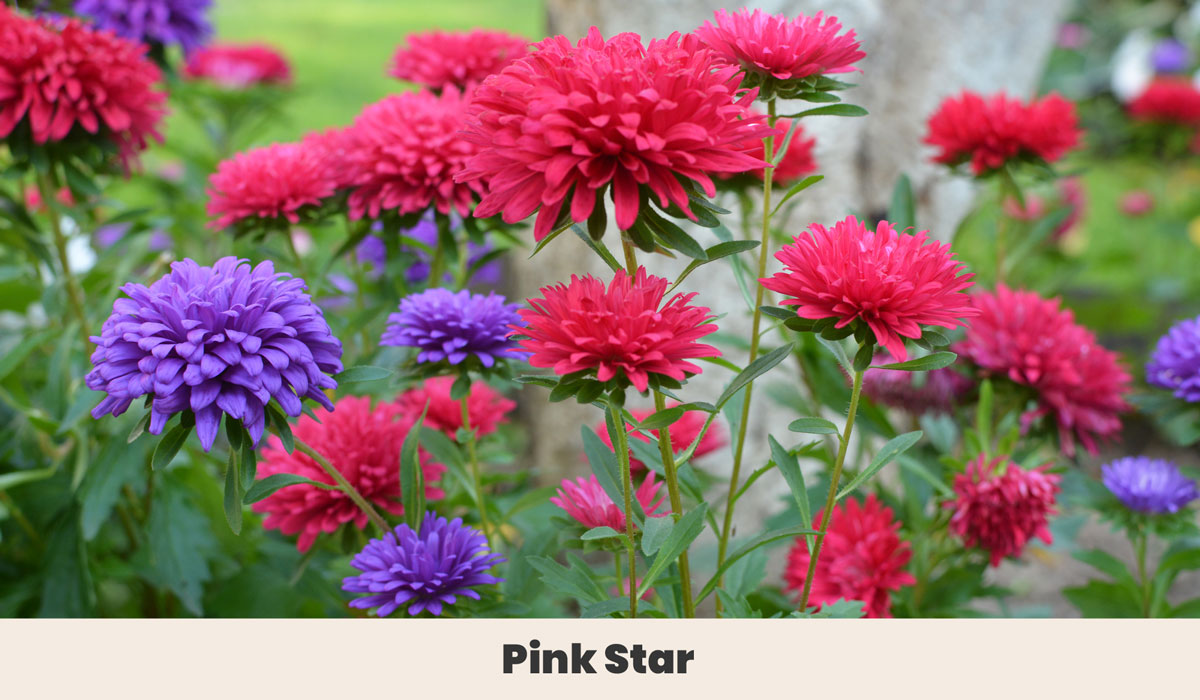
Pink Star (Aster ericoides) is a charming addition to any garden. This perennial features delicate pink flowers that bloom in late summer to early fall, creating a soft and romantic feel in the landscape. The flowers also let off a strong sweet fragrance, which adds to their allure.
Pink Star is a hardy plant that is easy to grow and maintain, making it an excellent choice for beginner and experienced gardeners. It prefers full sun to partial shade and well-draining soil but can tolerate some drought and heat. This plant is also an excellent option for attracting bees, butterflies, and other pollinators to your garden.
Overall, Pink Star is a lovely plant that can bring a touch of elegance to any garden while being low-maintenance and pollinator-friendly.
| Botanical Name: | Aster ericoides |
| Growth Rate: | Moderate |
| Blooming period: | Long |
| Hardiness Zones: | 4-8 |
| Light: | Full sun to partial shade |
| Soil Needs: | Well-draining soil with average to low fertility |
6. Cinderella (Asclepias incarnata)

Cinderella (Asclepias incarnata) is a must-have in any garden looking to attract pollinators. This tall perennial boasts clusters of delicate pink flowers that are irresistible to bees, butterflies, and other beneficial insects. But its beauty isn’t the only thing differentiating it from other perennials.
Cinderella, also known as swamp milkweed, is a host plant for the monarch butterfly. These iconic butterflies lay their eggs on the plant’s leaves, and the resulting caterpillars feed exclusively on the foliage. By including Cinderella in your garden, you’re not only providing a food source for adult butterflies, but you’re also supporting the next generation.
Another great thing about Cinderella is that it’s relatively easy to grow, and it prefers moist soil but can tolerate a range of conditions, including full sun to partial shade. And once it’s established, it’s pretty drought-tolerant, making it a low-maintenance addition to your garden.
| Botanical Name: | Asclepias incarnata |
| Growth Rate: | Moderate |
| Blooming period: | Long |
| Hardiness Zones: | 3-9 |
| Light: | Full sun to partial shade |
| Soil Needs: | Moist, well-draining soil that is rich in organic matter |
7. Snapdragons (Antirrhinum hispanicum)
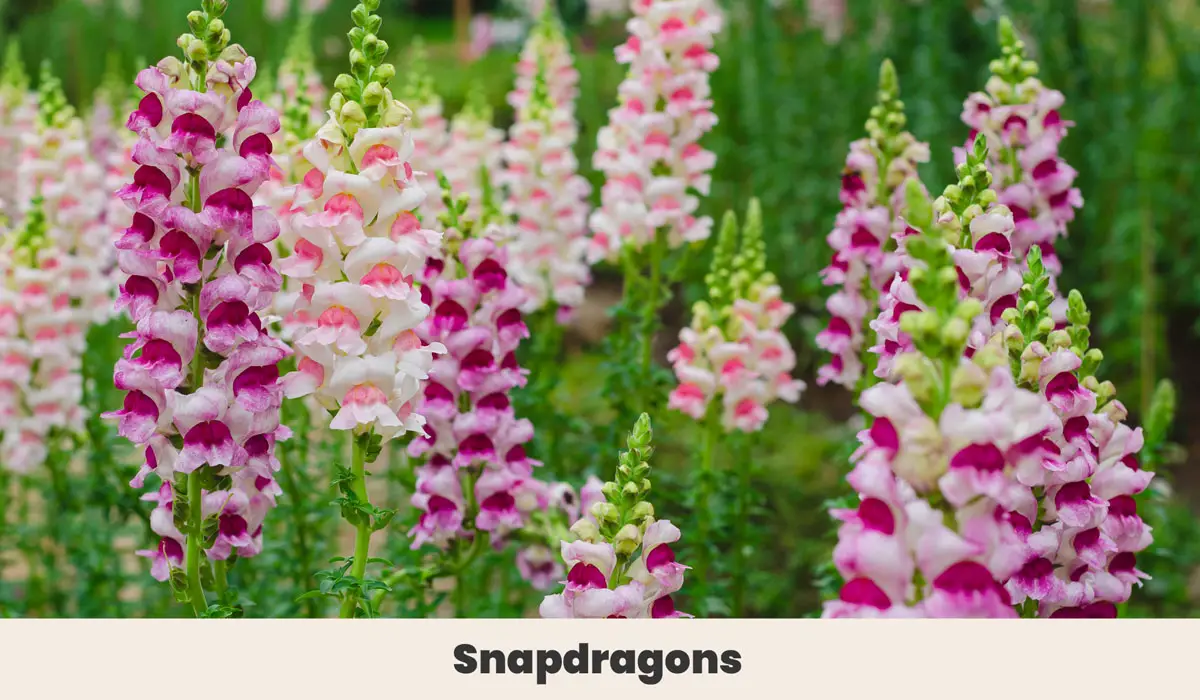
Snapdragons (Antirrhinum hispanicum) are delightful perennials that add a pop of color and a touch of whimsy to any garden. The flowers come in various colors, including pink, purple, yellow, and white, and are shaped like little dragon heads that open and close when you gently squeeze them. I love planting these in the front of my garden beds, where they add a playful touch to the landscape.
Snapdragons prefer full sun to partial shade and well-draining soil, and they can thrive in various climates. They also attract bees and butterflies, making them an excellent choice for pollinator gardens. One of the best things about snapdragons is that they reseed themselves so that you can enjoy this charming flowers year after year with minimal effort.
| Botanical Name: | Antirrhinum hispanicum |
| Growth Rate: | Moderate |
| Blooming period: | Long |
| Hardiness Zones: | 7-11 |
| Light: | Full sun to partial shade |
| Soil Needs: | Well-drained, fertile soil |
8. Amber Moon (Astilbe chinensis)
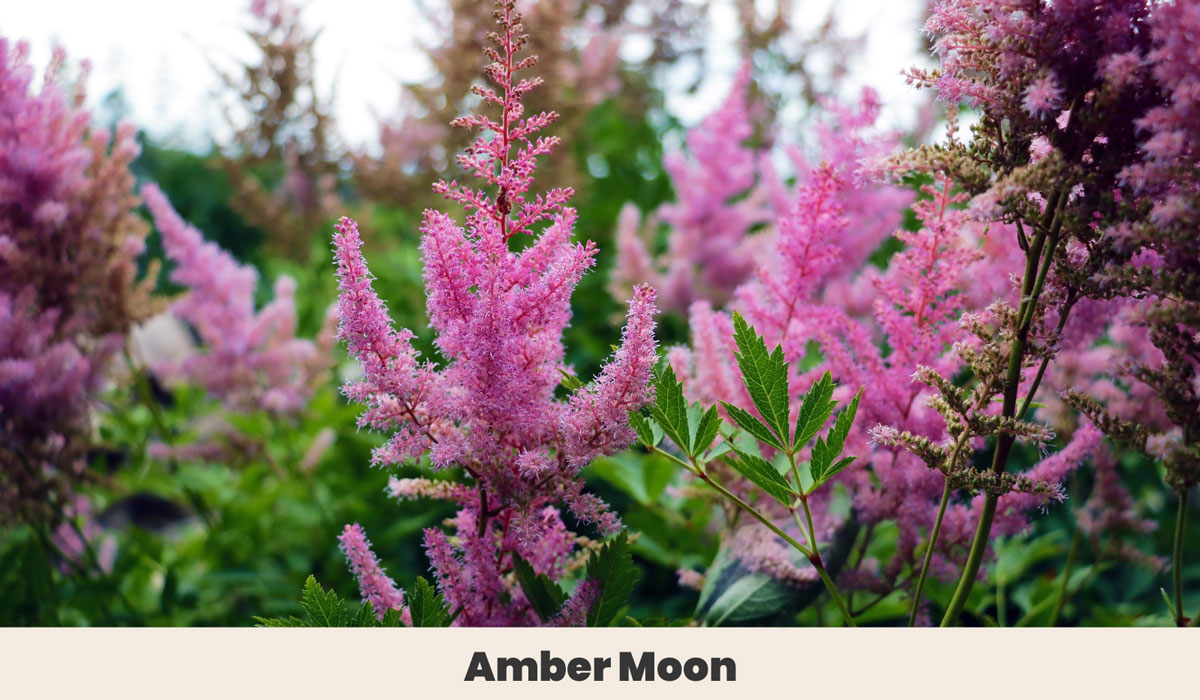
As a lover of all things floral, I can confidently say that Amber Moon (Astilbe chinensis) is a stunning perennial that should be on everyone’s gardening list.
The plant’s feathery plumes of pinkish-purple flowers add a touch of elegance and grace to any landscape. This showstopper blooms from late spring to early summer, making it a perfect choice for gardens that need a bit of extra color during that time.
What I love about this plant is how versatile it is. It can grow in various conditions, from full sun to partial shade, and can tolerate a range of soil types. Plus, it’s low maintenance, so it’s perfect for those who want a beautiful garden without much upkeep.
If you want a plant to make your garden stand out, I highly recommend Amber Moon. Its stunning blooms, and easy-to-grow nature make it the perfect addition to any garden.
| Botanical Name: | Astilbe chinensis |
| Growth Rate: | Moderate |
| Blooming period: | Long |
| Hardiness Zones: | 4-8 |
| Light: | Partial shade to full shade |
| Soil Needs: | Moist, well-drained, humus-rich soil |
9. Bleeding Heart (Dicentra spectabilis)
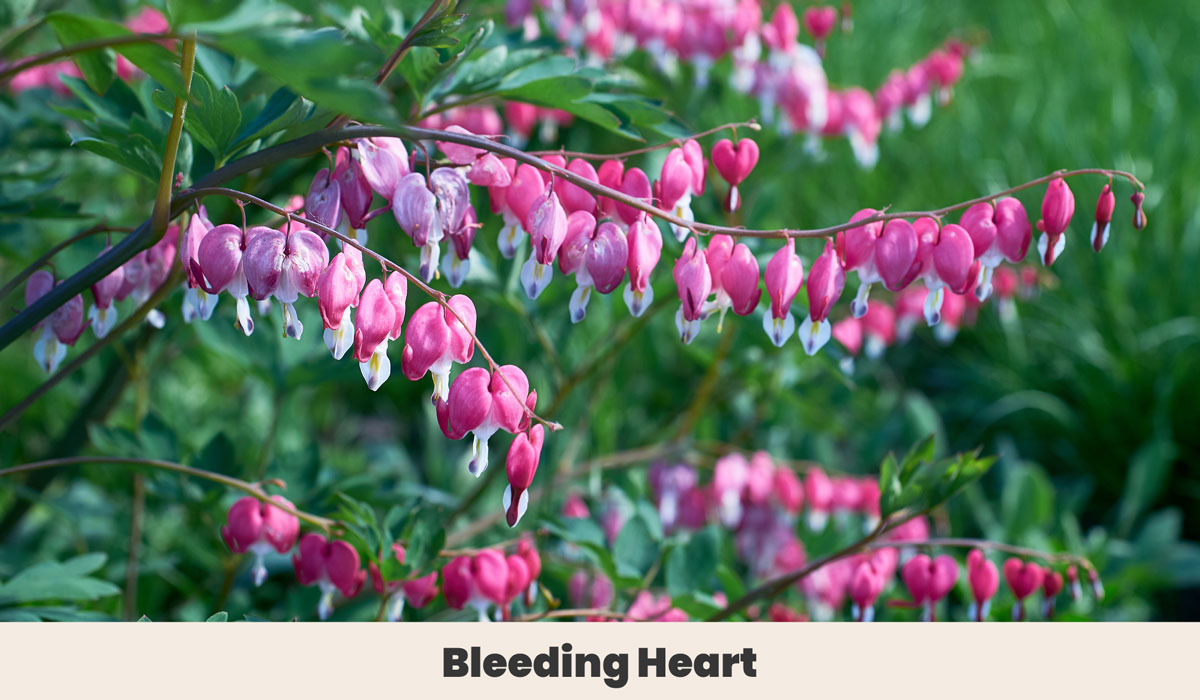
Bleeding Heart (Dicentra spectabilis) is a classic cottage garden plant with delicate pink heart-shaped flowers. It’s an old-fashioned favorite that adds a touch of romance to any garden.
The fern-like foliage adds texture to the garden even when the plant is not in bloom. Bleeding Heart prefers a shady spot with moist, well-drained soil, making it an excellent choice for woodland gardens.
One unique thing about Bleeding Heart is that the flowers are borne on arching stems, creating a graceful, drooping effect. The plant blooms in late spring to early summer, and if the flowers are deadheaded, it may bloom again in the fall.
Despite its delicate appearance, Bleeding Heart is a tough plant that can survive in cold temperatures and is relatively disease and pest-resistant.
| Botanical Name: | Dicentra spectabilis |
| Growth Rate: | Moderate |
| Blooming period: | Long |
| Hardiness Zones: | 4-8 |
| Light: | Partial shade to full shade |
| Soil Needs: | Moist, well-drained, humus-rich soil |
10. Showy Stonecrop (Sedum spectabile)
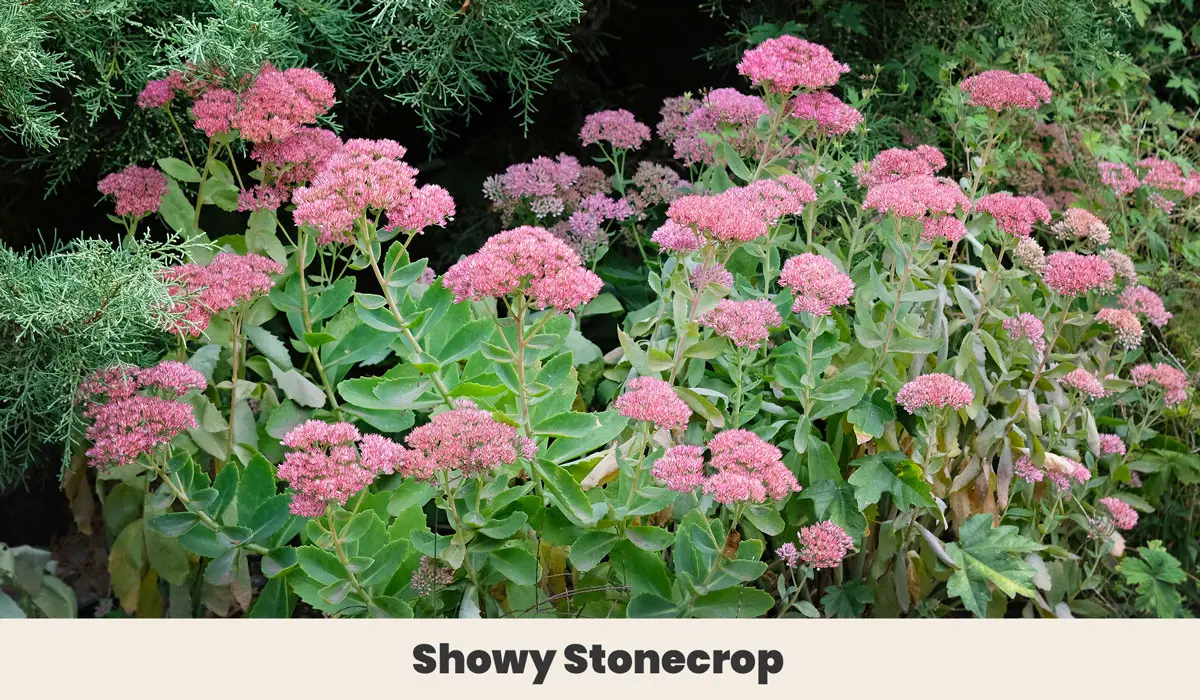
On my hunt for new plants to grow I’m always looking for plants that can add beauty and functionality to my garden. One plant that has caught my eye recently is Showy Stonecrop, also known as Sedum spectabile.
This hardy perennial produces large, flat clusters of pink or red flowers that bloom in late summer and early fall. The flowers are a favorite of bees and butterflies, making them a great addition to a pollinator garden. The plant is also quite hardy, able to withstand various growing conditions, from full sun to partial shade, and can even tolerate drought once established.
But what I love most about Showy Stonecrop is its versatility. It can be planted in rock gardens, used as a groundcover, or grown in containers. And as the temperatures drop, the plant’s foliage takes on a reddish hue, adding even more visual interest to the garden.
| Botanical Name: | Sedum spectabile |
| Growth Rate: | Moderate to fast |
| Blooming period: | Long |
| Hardiness Zones: | 3-9 |
| Light: | Full sun to partial shade |
| Soil Needs: | Well-draining sandy loam |
| Pot Size: | Medium |
| Water needs: | Low to moderate |
11. Hellebore (Helleborus hybridus)
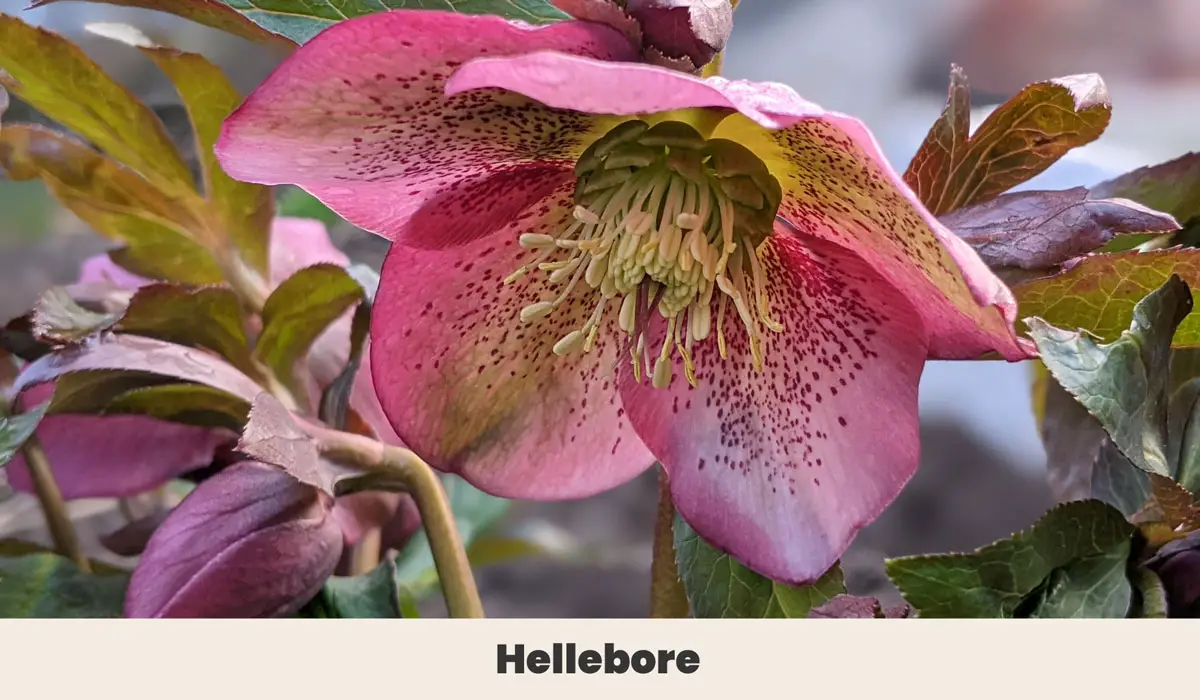
Hellebore, also known as the Lenten Rose, is one of my favorites! This stunning perennial is known for its exquisite blooms in late winter to early spring when our gardens need a burst of color.
Hellebores come in various colors, from pure white to deep burgundy, and are often sprinkled or veined with contrasting shades. They are also incredibly hardy, able to tolerate multiple growing conditions, and even bloom in partial shade.
One of the best things about Hellebores is their long blooming period, which can last several months. And as a bonus, they are also deer-resistant, making them an excellent choice for gardens in areas with high deer populations.
They are not quite as tall as some of the other flowers on this list but I couldn’t help to include Hellebores for their dramatic stance in my garden with blooms well above the base of their stems.
| Botanical Name: | Helleborus hybridus |
| Growth Rate: | Slow to moderate |
| Blooming period: | Long |
| Hardiness Zones: | 4-9 |
| Light: | Partial to full shade |
| Soil Needs: | Well-draining, moist soil with high organic matter |
12. Lupin (Lupinus)
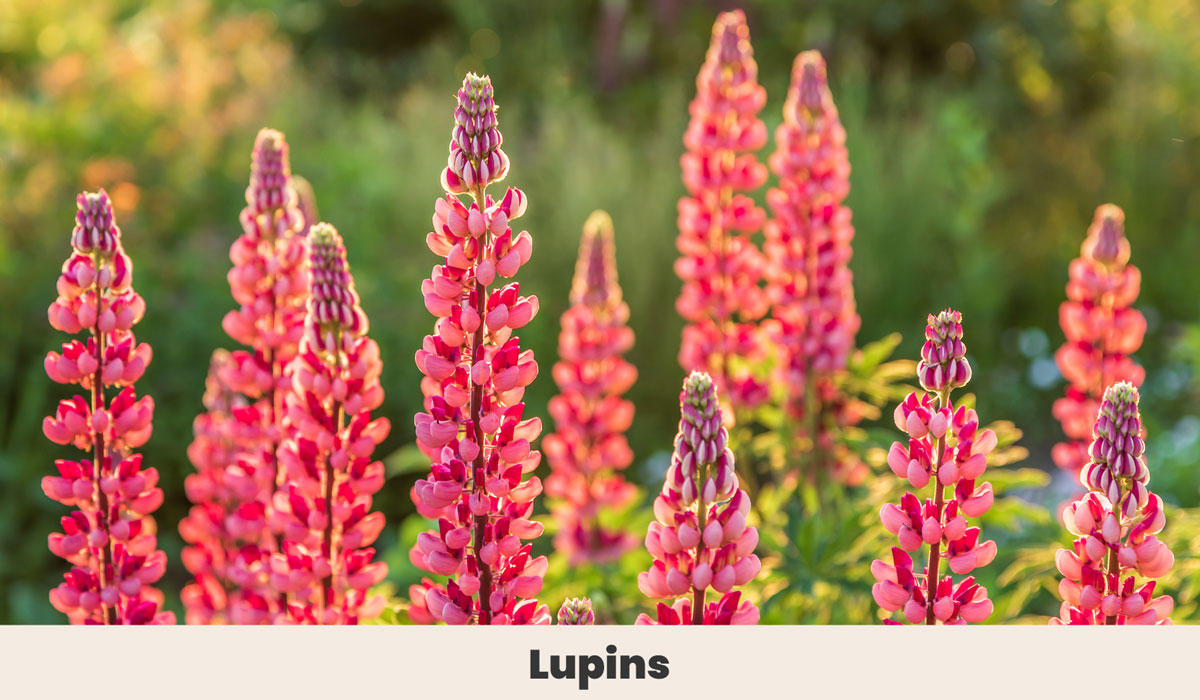
I cannot help but express my admiration for Lupin (Lupinus). This beautiful and versatile perennial comes in a wide range of colors, from soft pastels to bold, vibrant hues, and it’s a true standout in any garden.
Lupins are incredibly easy to grow and can thrive in various conditions, making them an excellent choice for both beginner and experienced gardeners. They prefer well-draining soil and full sun but can also tolerate partial shade. And once established, they require very little maintenance, making them a low-maintenance addition to any garden.
One of the best things about Lupins is that they attract pollinators like bees and butterflies, which can help increase your garden’s biodiversity. And with their beautiful flowers, they’re sure to add a touch of color and beauty to any outdoor space.
| Botanical Name: | Lupinus |
| Growth Rate: | Moderate |
| Blooming period: | Short |
| Hardiness Zones: | 3-9 |
| Light: | Full sun to partial shade |
| Soil Needs: | Well-draining soil |
Before you Go!
Well, there you have it! 12 of my favorite tall pink flowering perennials. If you found any of this info useful, let me know in the comments below. I would love to hear what you think. 😊
If you have the time check out these similar posts I’ve put together. if you made it this far chances are you will LOVE these as well
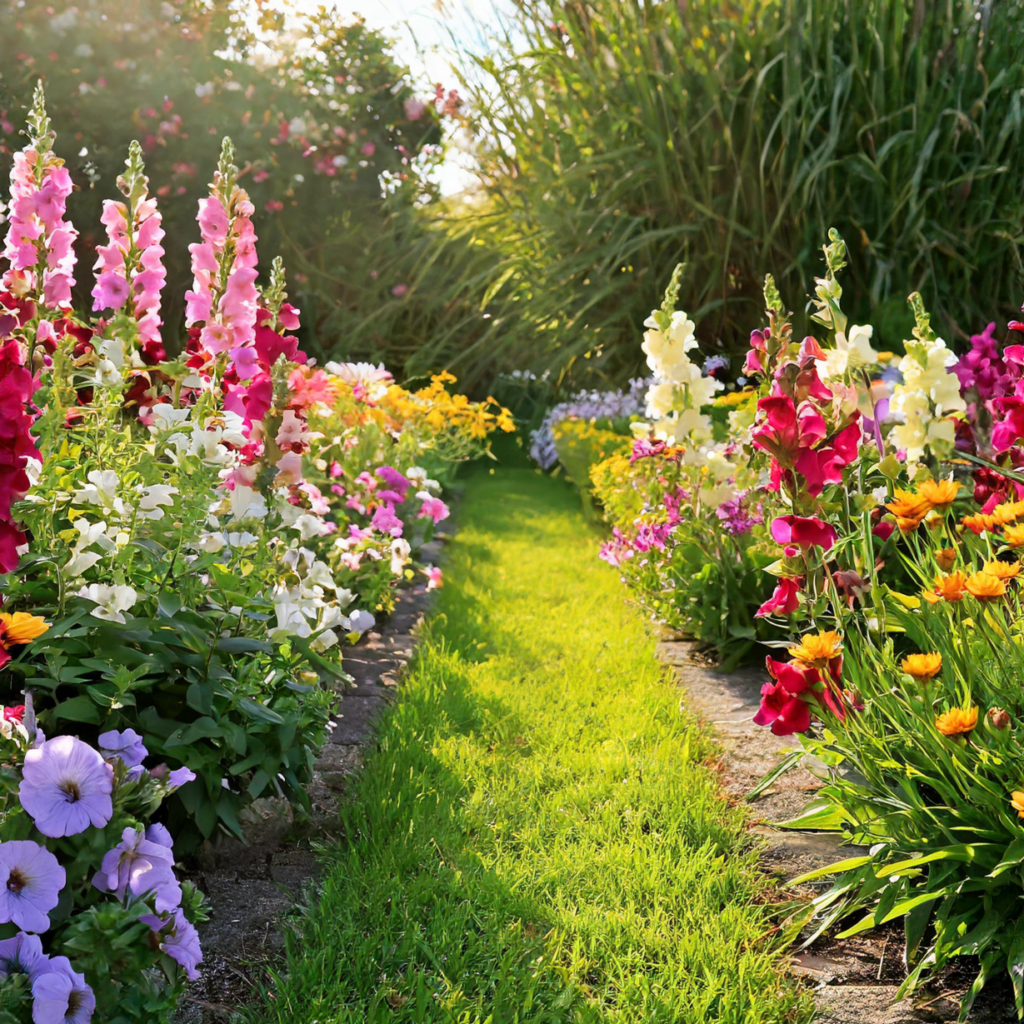
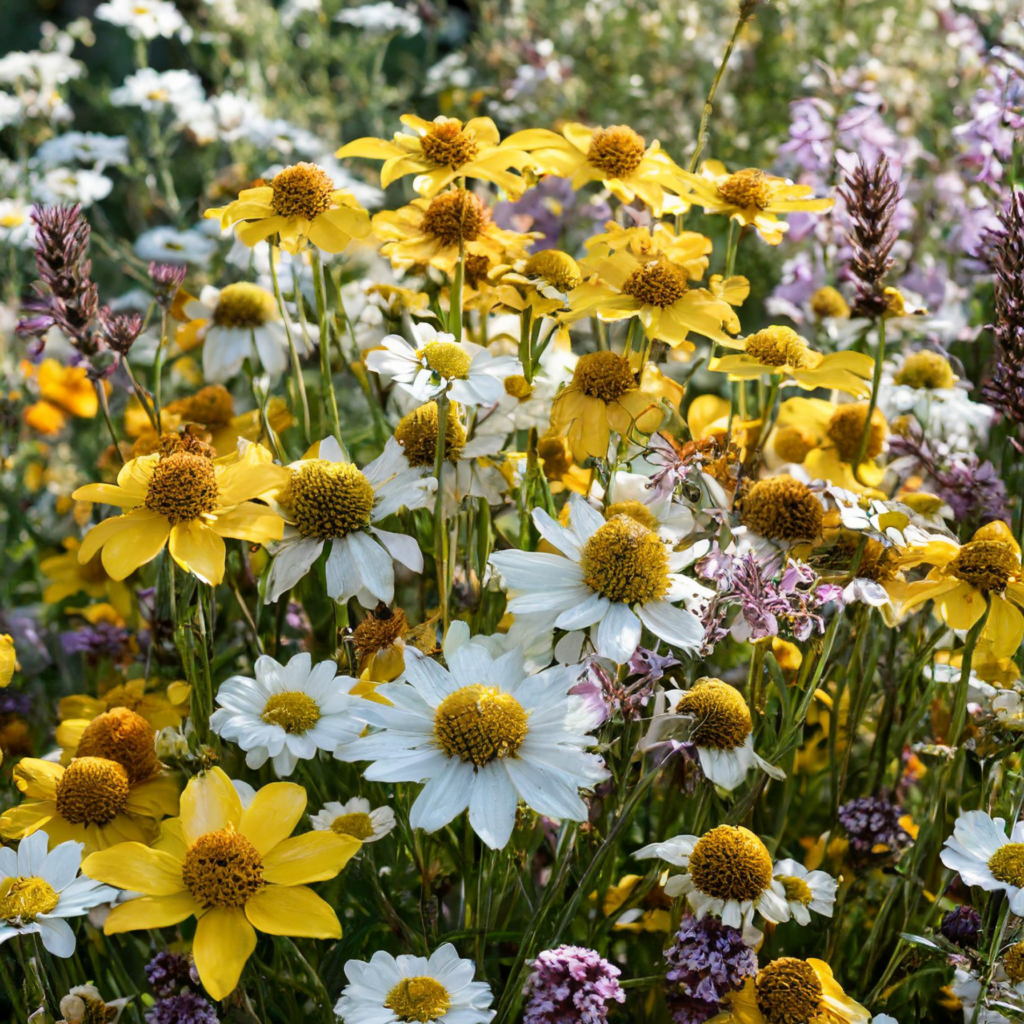
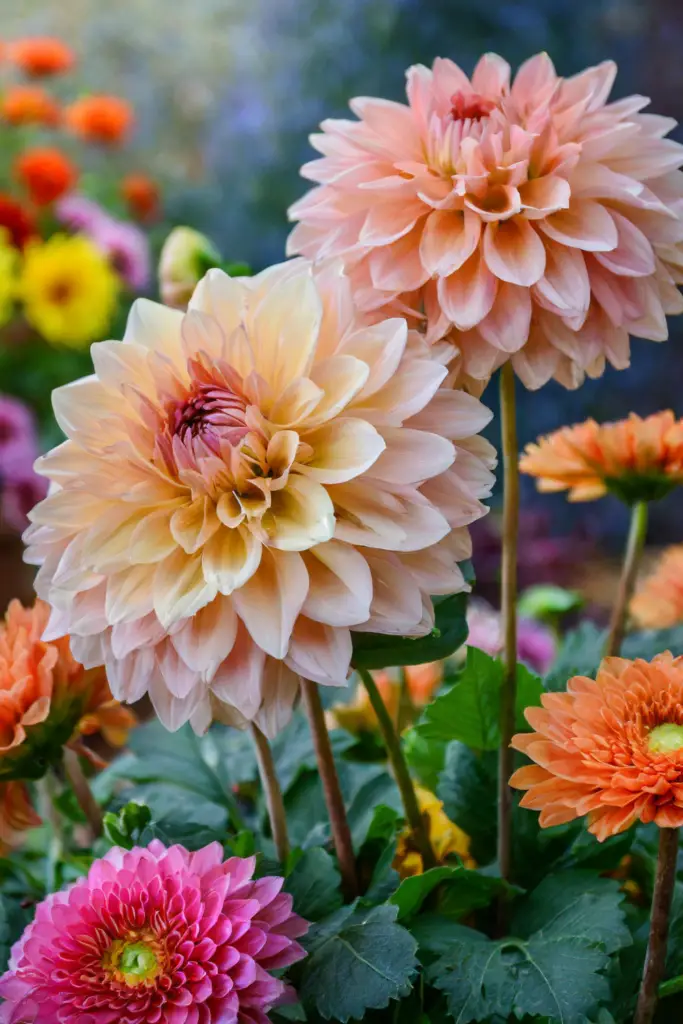


Would Lupins survive in large pots over the winter in cold climates?
Hi Jen! Lupins will overwinter down to zone 4 or just about anywhere in southern Canadian provinces and most states other than Montana and North Dakota. I would bring your pots into a greenhouse or cold frame to avoid any cold snap shocks. 🙂